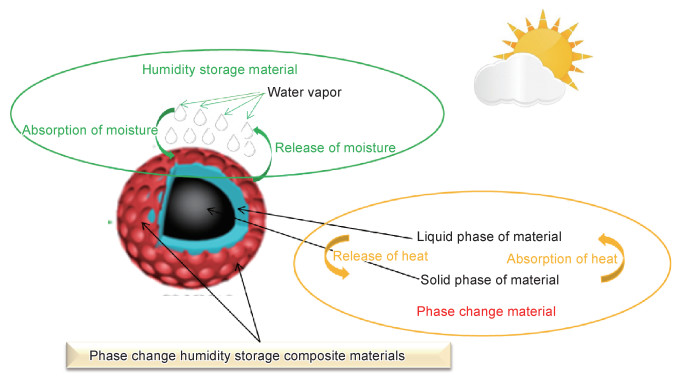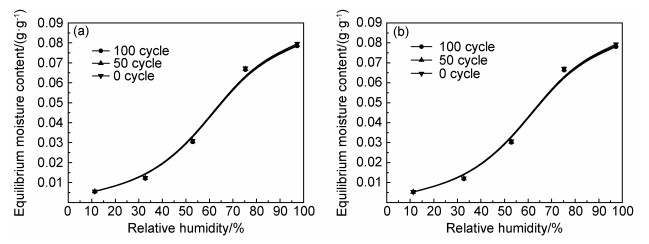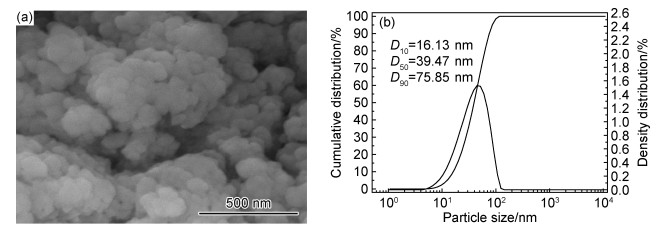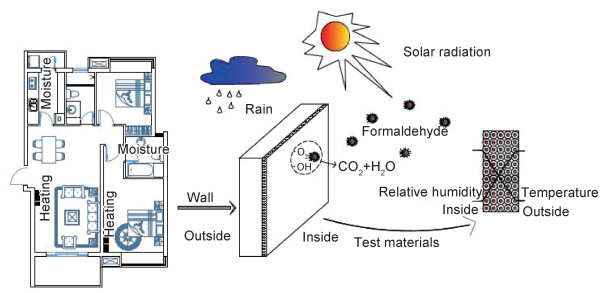
文章信息
- 张浩, 臧君杰, 李海丽, 宗志芳
- ZHANG Hao, ZANG Jun-jie, LI Hai-li, ZONG Zhi-fang
- 相变储湿复合材料及其应用研究进展
- Research status and application of phase change humidity storage composite materials
- 材料工程, 2021, 49(5): 56-65
- Journal of Materials Engineering, 2021, 49(5): 56-65.
- http://dx.doi.org/10.11868/j.issn.1001-4381.2020.000792
-
文章历史
- 收稿日期: 2020-08-20
- 修订日期: 2021-01-13
室内环境是人一生度过的主要空间,其舒适度(如温度、湿度)至关重要[1-2]。因此,采用多种电器设备进行室内空气温湿度调节,如供暖和制冷设备调节室内空气温度、人工加湿设备控制室内空气湿度,虽然可以提供良好的舒适度,但是必然导致大量能源的消耗[3-4]。所以,研究被动式建筑节能技术,如材料自身具有的“被动调节能力”降低建筑能耗,已经引起建筑领域和材料领域的极大兴趣。
近年来,一方面建筑领域通过传热理论分析墙体在非稳定条件下,室内温湿度变化,尤其当室内外环境温湿度作用于材料时,材料的热湿性能及相关参数很大程度地影响建筑节能效果;另一方面材料领域研究新型功能材料,尤其对具有调节室内环境湿度作用的材料不断探索,相关建筑节能理论及模拟分析需要依赖于材料热湿性能的准确评价,以满足人们不断提高的室内舒适度要求[5]。因此,以材料发展和研究为视角,从材料复合化机理入手,利用具有“被动调节能力”,即相变调温性能和储湿调湿性能,对改善室内环境舒适度和提升建筑节能具有非常重要的现实意义。本文对相变储湿复合材料在建筑墙体材料中的应用情况进行了具体的分析,详细指出了双壳微纳米相变胶囊、多元脂肪酸/SiO2相变储湿复合材料和癸酸-棕榈酸@Ce-La/TiO2复合材料的特点,详细评述了相变储湿复合材料存在的主要问题及其研究现状。
1 相变储湿复合材料概述 1.1 相变储湿复合材料的原理相变储湿复合材料是以相变材料作为相变调温基元材料,储湿材料作为储湿调湿基元材料,从材料复合化机理入手,形成具有调温调湿性能的复合材料,如图 1所示。其中相变材料(相变调温基元材料)利用物质发生相变时需要吸收或放出大量热量的性质来储存或放出热能,进而调整、控制工作源或材料周围环境温度;储湿材料(储湿调湿基元材料)依靠自身的吸放湿性能,感应所调空间空气温湿度的变化,从而自动调节空气相对湿度。

|
图 1 相变储湿复合材料原理图 Fig. 1 Schematic diagram of phase change humidity storage composite materials |
相变材料在发生固-液相变过程时易出现液化渗漏的问题,所以需要对其进行封装形成外观形状为球形颗粒或多边形颗粒的复合相变材料。目前封装技术分为相变微胶囊与定形相变材料,其中相变微胶囊是将小的球形的或杆形的相变材料颗粒封装在薄的高分子膜中[6],定形相变材料是将相变材料吸入分割好的特殊(柔软且自由流动)基质材料中[7]。
1.2.1 相变微胶囊的封装技术国外学者制备相变微胶囊取得了一定的成果,如表 1所示[8-15]。从表 1可以看出,相变微胶囊中芯材为有机烷烃材料,壁材为天然高分子或半合成高分子材料,且相变温度与相变潜热的跨度大。
| Core material | Wall material | Preparation method | Phase change temperature/℃ |
Transformation latent heat/ (J·g-1) |
Reference |
| n-Tetradecane | Polyurea | In-situ polymerization | 42.0 | 134.2 | [8] |
| n-Hexadecane | Toluene diisocyanate & diamine | Interfacial polymerization | 37.0 | 48.0-66.0 | [9] |
| n-Pentadecane | Methyl methacrylate | Suspension polymerization | 28.0-43.0 | 97.0-107.0 | [10] |
| n-Pentadecane | Methyl methacrylate | In-situ polymerization | 9.0-10.0 | 97.0-107.0 | [11] |
| n-Octadecane | Polyurea | Interfacial polymerization | 30.0 | 241.2 | [12] |
| n-Docosane | Polymethyl methacrylate | In-situ emulsion polymerization | 50.0 | 54.6 | [13] |
| n-Octadecane | Sodium silicate precursor | Sol-gel synthesis | 31.0-36.0 | 87.5 | [14] |
| Carboxylic acid | Epoxy resin | Interfacial polymerization | 38.0 | 96.2 | [15] |
国内于20世纪70年代末、80年代初,研究者相继开始采用多种方法制备相变微胶囊。陈春明等利用细乳液法制备了正十二醇/聚合物纳米相变胶囊,其相变潜热及相变材料包封效率分别为109.3 J/g和92.1%[16]。余飞等采用原位聚合法合成了具有高储热密度的相变储热微胶囊,其芯材为正十二醇、壁材为三聚氰胺-甲醛树脂[17]。单晓辉等采用乳液聚合法制备粒径为6 μm左右的相变材料微胶囊,其芯材为正十八烷、壁材为苯乙烯-甲基丙烯酸共聚物,相变热焓为137.5 J/g[18]。
综上所述,相变微胶囊的封装技术不仅解决了相变材料在固-液转变过程中易渗漏的问题,而且制备了相变潜热性能良好的复合相变材料;但是也存在相变微胶囊技术制备方法复杂、工艺参数难以控制以及壁材为有机高分子材料与建筑材料相容性差的问题。
1.2.2 定形相变材料的封装技术国内外学者针对定形相变材料封装技术在制备方法与工艺方面进行了大量的研究,其具体方法如下:
溶胶-凝胶法,即将前驱体溶于水或有机溶剂中形成均质溶液,然后通过溶质发生水解反应生成纳米级的粒子并形成溶胶,溶胶经蒸发干燥转变为凝胶来制备定形相变材料[19]。该方法的优点是原料反应黏度低、无机与有机分子混合均匀[20],产物的组成实现分子设计和剪裁[21],工艺过程温度低、易操作;制备的定形相变材料纯度高[22]。
物理共混法,即利用物理相互作用把固-液相变材料固定在载体上,包括吸附作用或包封技术制备定形相变材料[23]。该方法的优点是相变材料在超过相变温度时,定形相变材料在宏观上仍能保持其固体形态,而在微观上发生固-液相变;缺点是定形相变材料经多次使用时,易发生相变材料与支撑载体脱附及渗漏[24-25]。
化学共混法,即利用嵌段共聚或接枝共聚等化学方法改性,制备主链侧链型的固-固定形相变材料[26-27]。该方法的优点是制备的定形相变材料具有很好的热稳定性;缺点是工艺复杂,不能进行热加工和热成型[28]。
吸附多孔基质法,即利用具有微孔结构的无机物作为支撑材料,通过微孔的毛细作用力将液态的有机物或无机物相变储热材料吸入微孔内,形成有机/无机或无机/有机复合定形相变材料[29-30]。该方法的优点是多孔介质一方面可以实现结构-功能一体化,另一方面可以将相变物质分散为细小的个体,提高相变过程的换热效率。
综上所述,定形相变材料的封装技术不仅解决了固-液相变过程中相变材料易渗漏的问题,而且壁材为无机多孔材料与建筑材料相容性好。
1.3 调湿材料的分类与选择目前国内外学者将调湿材料分为无机盐类调湿材料、无机多孔类调湿材料和有机高分子类调湿材料。
无机盐类调湿材料是利用无机盐饱和盐溶液对应于一定的饱和蒸汽压[31]。当外界湿度低于其对应的相对湿度时,促使水分挥发,从而阻止湿度下降;当外界湿度高于其对应的相对湿度时,促使盐溶液吸收水分,从而阻止湿度上升[32]。但是无机盐类调湿材料随着吸湿量增加,自身慢慢潮解,对环境产生污染。
无机多孔类调湿材料是利用其比表面积和孔容积对水蒸气进行物理吸附[33],具有良好的均匀透过性和耐高温、抗腐蚀等性能[34]。无机多孔类调湿材料吸放湿速度快、放湿滞后小,对人体和环境无毒无害,生产工艺简单、制造成本低、使用寿命长。
有机高分子类调湿材料是由具有三维交联网状结构的超强吸水性能树脂构成,具有吸湿容量高的特点[35-36]。但是有机高分子类调湿材料生产工艺复杂、成本高、功能寿命短[37]。
综上所述,无机多孔类调湿材料不仅环保性能优越,而且与以无机材料为主的建筑材料相容性良好,是相变储湿复合材料中调湿基元材料的首选。
2 相变储湿复合材料在建筑墙体材料中的应用 2.1 双壳微纳米相变胶囊用于建筑石膏相变储湿复合材料是利用材料在不同相态下互相转换的过程来储存或者释放热量及水分,在这个过程中,该材料可以对周围环境中的温湿度进行调节,具有一定的相变调温、储湿调湿的作用。西安建筑科技大学尚建丽教授团队对相变储湿复合材料进行了一系列的研究,在2013年尚建丽团队制备出了PAR/POL/SOD复合微胶囊,该复合微胶囊的核为相变石蜡,壳体为树脂聚丙烯酸酯材料,其中高吸油性树脂聚丙烯酸酯为疏水内壳、高吸水性树脂聚丙烯酸钠为亲水外壳[38],实现了相变调温性能与储湿调湿性能的一体化,但是其储湿调湿性能有限;在2015年针对PAR/POL/SOD复合微胶囊储湿调湿性能有限的问题,采取了以正十八烷为核、聚苯乙烯为内壳、甲基丙烯酸甲酯与壳聚糖接枝为外壳的结构,其制备的双壳纳米相变微胶囊相变调温性能良好,且储湿调湿性能提升,即在相对湿度11.30%~97.30%时吸湿量可以达0.0125~0.1797 g/g[39]。将双壳微纳米相变胶囊与建筑石膏按质量比3∶7进行复合制备以石膏为基体的复合材料[40]。
图 2为双壳微纳米相变胶囊的FTIR与SEM测试结果[41]。从图 2(a)可以看出,双壳微纳米相变胶囊在2921.28 cm-1处出现—CH2上的C—H拉伸振动,在1729.26 cm-1处出现酯基CO伸缩振动的特征吸收峰,在759.92 cm-1处出现—CH2—摇摆吸收峰,说明外壳中甲基丙烯酸甲酯与壳聚糖的接枝效果良好,对以聚苯乙烯为内壳、正十八烷为核的胶囊进行包覆。从图 2(b)可以看出,双壳微纳米相变胶囊的外观呈现规则球形且表面光滑,其结构致密无显著缺陷,粒径为200~300 nm,说明双壳微纳米相变胶囊已经达到微纳米级。
表 2为石膏基双壳微纳米相变胶囊复合材料的储放热性能,图 3为石膏基双壳微纳米相变胶囊复合材料的吸放湿性能。结合表 2与图 3可以看出,石膏基双壳微纳米相变胶囊复合材料经过50次和100次储放热循环实验和吸放湿循环实验后,其储放热性能与吸放湿性能均基本稳定,说明石膏基双壳微纳米相变胶囊复合材料耐久性良好,可以用于建筑材料领域。
许多专家学者针对定形相变储湿复合材料的制备进行了大量的理论分析及实验研究,总结出了一些相变材料的制备方法。尚建丽等利用硅-氧之间的化学键的断裂以及重新组合的原理,采用溶胶-凝胶法制备癸酸-棕榈酸/SiO2相变储湿复合材料,其中以SiO2为基体、癸酸-棕榈酸为相变材料。对该复合材料的FTIR图谱进行分析可以看出,SiO2与酸之间仅为物理作用,即癸酸-棕榈酸填充在Si—O—Si基团结构孔隙中。Si—O—Si基团结构孔隙利用其多孔吸附的作用可以吸收周围环境中的水分,以达到调节湿度;同时这些“孔”以及其中的癸酸-棕榈酸也可以达到调节温度[42]。将癸酸-棕榈酸/SiO2相变储湿复合材料与建筑石膏按质量比2∶3进行复合制备具有一定调温调湿作用的抹灰石膏,即石膏基相变储湿复合材料[43]。
图 4为癸酸-棕榈酸/SiO2相变储湿复合材料的SEM与LPSA测试结果[44]。从图 4(a)可以看出,癸酸-棕榈酸/SiO2相变储湿复合材料的表面是光滑圆润的球体结构,通过对该材料的结构进行微观检测可以发现该材料粒径较小且分布均匀,并不会出现颗粒物堆积串联,也没有出现大面积薄层状有机物,这是因为SiO2形成的硅氧之间的化学键稳定,可以将癸酸-棕榈酸严密锁在SiO2的网络孔结构中,SiO2的表面不会出现癸酸-棕榈酸。从图 4(b)可以看出,癸酸-棕榈酸/SiO2相变储湿复合材料的粒径分布为16.13~75.85 nm,(d90-d10)/d50=1.51,根据材料粒径均匀分布情况,可以看出该材料属于纳米级材料。
图 5为石膏基相变储湿复合材料的性能[43]。从图 5可以看出,石膏基相变储湿复合材料分别经过100次、200次和300次的步冷循环实验和吸放湿循环实验后,其性能均有小幅度下滑,即石膏基相变储湿复合材料经过300次循环实验后,其相变调温性能仅下降7.20%,储湿调湿性能下降6.44%~9.45%,说明石膏基相变储湿复合材料具有良好的耐久性。
在尚建丽教授的研发基础上,张浩以棕榈醇(十六醇)-棕榈酸(十六酸)-月桂酸(十二酸)为相变材料,制备出性能更优的十六醇-十六酸-十二酸/SiO2三元相变储湿复合材料,其相变温度为26.29 ℃,相变潜热为70.55 J/g,在相对湿度40%~65%时的平衡含湿量为0.0700~0.1000 g/g[45]。将十六醇-十六酸-十二酸/SiO2三元相变储湿复合材料与抹灰石膏按照一定配方比例进行复合制备新型石膏基相变储湿复合材料。目前对于具有调温调湿功能的石膏墙体建筑材料的研究不多,但是在建筑物建设时需要考虑建筑物的温湿度变化,由此可见其应用前景甚为可观。
2.3 癸酸-棕榈酸@Ce-La/TiO2复合材料用于面层抹灰石膏面层抹灰石膏具有施工周期短、对比于普通水泥凝固快且环境友好的特点,因此在建筑领域被广泛应用。同时相关专家学者对如何进一步提高面层抹灰石膏的性能进行研究,如在面层抹灰石膏中加入某些功能材料以提高其性能。宗志芳等利用溶胶-凝胶法与负压技术相结合,以癸酸-棕榈酸为复合相变材料、Ce-La改性TiO2制备Ce-La/TiO2空心微球,制备癸酸-棕榈酸@Ce-La/TiO2复合材料,其不仅具有调温调湿性能,而且在实验过程中发现在可见光源的作用下还具有降解甲醛性能[46-47]。由于癸酸-棕榈酸@Ce-La/TiO2复合材料兼有调温调湿及降解甲醛的性能,将其与面层抹灰石膏进行复配制备石膏基环境协调型复合材料,其相变温度为24.67 ℃,相变潜热为23.57 J/g,在相对湿度32.78%~84.34%时的平衡含湿量为0.0167~0.0811 g/g,经过6 h对甲醛的降解率能够达到43.52%[48]。
图 6为癸酸-棕榈酸@Ce-La/TiO2复合材料的SEM与吸附/脱附等温测试结果[48]。从图 6(a)可以看出,癸酸-棕榈酸@Ce-La/TiO2复合材料的粒径均匀,但表面并不光滑,具有明显的小孔且无癸酸-棕榈酸吸附表面,说明癸酸-棕榈酸被较好地密封于Ce-La/TiO2空心微球内。从图 6(b)可以看出,癸酸-棕榈酸@Ce-La/TiO2复合材料的吸附回线与H3型较为接近且具有H4型的结构特征,说明Ce-La/TiO2空心微球被癸酸-棕榈酸充填后,其内部空腔的多孔结构趋向无规则化发展。将癸酸-棕榈酸@Ce-La/TiO2复合材料用于面层抹灰石膏的性能协同示意图,如图 7所示[48-49]。
相变储湿复合材料是一种具有“被动调节能力”的绿色环保功能材料,其在温控、湿控、蓄热、储湿等新领域具有极其广阔的商业应用前景。但是同时相变储湿复合材料中相变材料热导率低、储湿材料放湿滞后的问题成为技术壁垒,阻碍了其大规模的应用普及。近年来,相关科学工作者对阻碍相变储湿复合材料应用的技术壁垒进行了大量研究,推动了相变储湿复合材料的快速发展。
3.1 相变材料热导率低相变储湿复合材料中大部分脂肪酸类相变材料的热导率较低,这是因为其在固-液相变过程中临近热源的相变材料吸收大量热量后已经完全熔化,但是远离热源的相变材料吸收少量热量还未进行熔化。由于相变材料在固-液相变过程中的不协调性,大幅度降低相变储湿复合材料的应用效果。目前提高脂肪酸类相变材料热导率的方法可以借鉴提高石蜡类相变材料热导率的科研成果,即采用高导热骨架(石墨与金属泡沫骨架)[50-51]和添加高热导率粒子(氧化石墨烯、碳纤维和石墨烯)[52-54]。
3.2 储湿材料放湿滞后相变储湿复合材料中储湿材料普遍存在放湿滞后的问题,这是因为其在吸放湿过程中吸湿时水分子进入材料结构,导致材料结构间距增加,少数结构接点被迫拆开与水分子形成氢键,但是放湿时由于材料结构中存在较多对水分子具有吸引作用的极性分子,会阻止水分子离开且保留部分水分子,造成材料结构间距不能及时完整的恢复,影响相变储湿复合材料的调湿效果。目前降低储湿材料放湿滞后的方法包括选用无机多孔材料(沸石、海泡石、高岭土等)[55-57]和溶胶-凝胶法合成无定型SiO2或TiO2[58-60]。
4 结束语人类在面临化石能源日益枯竭的同时,却仍然难以解决能量利用率低的问题。相变储湿复合材料凭借其具有的相变调温性能和储湿调湿性能,可以广泛应用于建筑墙体材料,满足人们对室内环境舒适度日益增长的要求,以达到实际应用与商业推广的目的。近年来,国内科学工作者的研究成果为大规模的商业应用相变储湿复合材料提供了技术支持,今后的发展主要在以下两个方向:
(1) 优化相变储湿复合材料的耐久性:在现有材料的基础上,通过复合改性等方法提高封装技术的可靠性。此时研究者应注意,在提高相变储湿复合材料耐久性的同时,不能破坏其相变调温性能和储湿调湿性能。
(2) 开发多功能型相变储湿复合材料:以材料的相变调温性能和储湿调湿性能为基础,进一步赋予材料的光催化性能,实现调温、调湿和净化空气的一体化,以满足人们对室内生活环境“舒适度、节能、环保”的要求。
| [1] |
HUYNH C K. Building energy saving techniques and indoor air quality: a dilemma[J]. International Journal of Ventilation, 2010, 9(1): 93-98. DOI:10.1080/14733315.2010.11683872 |
| [2] |
BAUGHMAN A X, ARENS A E. Indoor humidity and human health: part1 literature review of health effects of humidity-influenced indoor pollutants[J]. ASHRAE Transactions, 1996, 102(1): 193-198. |
| [3] |
ZHU N, MA Z J, WANG S W. Dynamic characteristics and energy performance of buildings using phase change materials: a review[J]. Energy Conversion and Management, 2009, 50(12): 3169-3181. DOI:10.1016/j.enconman.2009.08.019 |
| [4] |
DENG A Z, LI S B, ZHUANG C L, et al. Research on lightweight PCM thermal-storing wall-material[J]. Journal of Building Materials, 2008, 11(5): 541-544. |
| [5] |
ZHANG H, FANG Y. Temperature dependent photoluminescence of surfactant assisted electrochemically synthesized ZnSe nanostructures[J]. Journal of Alloys and Compounds, 2019, 781: 201-208. DOI:10.1016/j.jallcom.2018.11.375 |
| [6] |
尚建丽, 张浩. 相变蓄能材料在建筑中应用现状与展望[J]. 化工新型材料, 2014, 42(9): 197-199. SHANG J L, ZHANG H. Application situation and prospect of phase change thermal energy storage materials in building[J]. New Chemical Materials, 2014, 42(9): 197-199. |
| [7] |
尚燕, 张雄. 新型相变储能技术的应用与发展[J]. 建筑节能, 2006, 34(2): 21-23. SHANG Y, ZHANG X. Application and development on the technology of phase change energy storage[J]. Construction Conserves Energy, 2006, 34(2): 21-23. |
| [8] |
RUBEN B, ARILD G. Phase change materials for building applications: a state-of-the-art review[J]. Energy and Buildings, 2010, 42: 1361-1368. DOI:10.1016/j.enbuild.2010.03.026 |
| [9] |
MONDAL S. Phase change materials for smart textiles-an overview[J]. Applied Thermal Engineering, 2008, 28(11/12): 1536-1550. |
| [10] |
HUANG M J, EAMES P C, HEWITT N J. The application of a validated numerical model to predict the energy conservation potential of using phase change materials in the fabric of a building[J]. Solar Energy Materials & Solar Cells, 2006, 90(13): 1951-1960. |
| [11] |
YOSHINARI T, HIROSHI Y, HIDEO K, et al. Preparation of PCM microencapsules by using oil absorbable polymer particles[J]. Colloids and Surfaces A, 2007, 301(1-3): 41-47. DOI:10.1016/j.colsurfa.2006.12.019 |
| [12] |
CHO J S, KWON A, CHO C G. Micro encapsulation of octadecane as a phase-change material by interfacial polymerization in an emulsion system[J]. Colloid and Polymer Science, 2002, 280(3): 260-266. DOI:10.1007/s00396-001-0603-x |
| [13] |
CEMIL A, SAN A, KARAIPEKLI A, et al. Preparation characterization and thermal properties of micro-encapsulated phase change material for thermal storage[J]. Solar Energy Material & Solar Cells, 2009, 93(1): 143-147. |
| [14] |
HE F, WANG X D, WU D Z. New approach for sol-gel synthesis of microencapsulated n-octadecane phase change material with silica wall using sodium silicate precursor[J]. Energy, 2014, 67(4): 223-233. |
| [15] |
OANA P, RICARD G V, MARTA G. Interfacial polymerization of an epoxy resin and carboxylic acids for the synthesis of micro-capsules[J]. Polymer International, 2008, 57(8): 995-1006. DOI:10.1002/pi.2438 |
| [16] |
陈春明, 陈中华, 曾幸荣. 细乳液聚合法制备正十二醇/聚合物相变纳米胶囊及其性能研究[J]. 功能材料, 2011, 11(42): 2112-2115. CHEN C M, CHEN Z H, ZENG X R. Synthesis and characterization of dodecanol/polymer phase change nanocapsules via miniemulsion polymerization[J]. Journal of Functional Materials, 2011, 11(42): 2112-2115. |
| [17] |
余飞, 陈中华, 曾幸荣. 正十二醇相变储热微胶囊的制备与表征[J]. 高分子材料科学与工程, 2009, 25(6): 135-138. YU F, CHEN Z H, ZENG X R. Preparation and characterization of thermal energy storage microcapsulated n-dodecanol by phase change[J]. Polymer Materials Science & Engineering, 2009, 25(6): 135-138. DOI:10.3321/j.issn:1000-7555.2009.06.038 |
| [18] |
单晓辉, 裴广玲, 付中玉. 乳液聚合法制备正十八烷相变材料微胶囊[J]. 天津纺织科技, 2011(1): 25-27. SHAN X H, PEI G L, FU Z Y. Preparation of microPCMs by coating n-octadecane with emulsion polymerization[J]. Tianjin Textile Science & Technology, 2011(1): 25-27. |
| [19] |
林怡辉, 张正国, 王世平. 溶胶-凝胶法制备新型蓄能复合材料[J]. 太阳能学报, 2001, 22(3): 334-336. LIN Y H, ZHANG Z G, WANG S P. Sol-gel process for new heat storage composite materials preparation[J]. Acta Energiae Solaris Sinica, 2001, 22(3): 334-336. DOI:10.3321/j.issn:0254-0096.2001.03.019 |
| [20] |
尚燕, 张雄. 相变储能材料应用研究[J]. 西华大学学报(自然科学版), 2005, 24(2): 87-90. SHANG Y, ZHANG X. Study progress on phase change energy storage materials[J]. Sichuan University of Science and Technology, 2005, 24(2): 87-90. DOI:10.3969/j.issn.1673-159X.2005.02.025 |
| [21] |
凌双梅, 高学农, 尹辉斌. 低温相变蓄热材料研究进展[J]. 广东化工, 2007, 34(3): 48-51. LING S M, GAO X N, YIN H B. State-of-the-art of PCMs for heat storage at low temperature[J]. Guangdong Chemical Industry, 2007, 34(3): 48-51. DOI:10.3969/j.issn.1007-1865.2007.03.016 |
| [22] |
宋婧, 曾令可, 刘平安, 等. 蓄热材料中的纳米技术[J]. 中国陶瓷工业, 2007, 14(5): 35-38. SONG J, ZENG L K, LIU P A, et al. Nano technology applied in heat storage materials[J]. China Ceramic Industry, 2007, 14(5): 35-38. DOI:10.3969/j.issn.1006-2874.2007.05.010 |
| [23] |
ZHANG Z G, ZHANG N, PENG J, et al. Preparation and thermal energy storage properties of paraffin/expanded graphite composite phase change material[J]. Applied Energy, 2012, 91: 426-431. DOI:10.1016/j.apenergy.2011.10.014 |
| [24] |
仇影, 吴其胜, 黎水平, 等. 二元有机/煤系高岭土复合相变储能材料的制备及其热性能[J]. 材料科学与工程学报, 2013, 31(2): 269-272. QIU Y, WU Q S, LI S P, et al. Preparation and thermal properties of binary organic/kaolin composites as shape-stabilized phase change material for thermal energy storage[J]. Journal of Materials Science and Engineering, 2013, 31(2): 269-272. |
| [25] |
李玉红, 焦庆影, 夏定国, 等. 常低温相变储热材料的研究和应用[J]. 化学教育, 2004, 25(10): 9-13. LI Y H, JIAO Q Y, XIA D G, et al. The study and applications of normal and low temperature phase change and heat storage materials[J]. Journal of Chemical Education, 2004, 25(10): 9-13. DOI:10.3969/j.issn.1003-3807.2004.10.004 |
| [26] |
姜勇, 丁恩勇, 黎国康. 化学法和共混法制备的PEG/CDA相变材料的性能比较-储热性能与链结构的关系[J]. 纤维素科学与技术, 2000, 8(1): 17-25. JIANG Y, DING E Y, LI G K. Contrast studies on phase change materials of PEG/CDA prepared by chemical reactions or blendings-relationships between heat storage properties and structures[J]. Journal of Cellulose Science and Technology, 2000, 8(1): 17-25. DOI:10.3969/j.issn.1004-8405.2000.01.003 |
| [27] |
周建伟, 刘星. 相变储能材料的研究及应用新进展[J]. 河南化工, 2004(10): 7-10. ZHOU J W, LIU X. New progress on research and application of phase change energy storage materials[J]. Henan Chemical Industry, 2004(10): 7-10. DOI:10.3969/j.issn.1003-3467.2004.10.003 |
| [28] |
INADA H, YONEDA A, HORIBE A, et al. High density polyethylene as a thermal energy storage materials[J]. Nippon Kikai Gakkai Ronbunshu B, 1997, 63(605): 282-289. |
| [29] |
施韬, 孙伟, 王倩楠. 凹凸棒土吸附相变储能复合材料制备及其热物理性能表征[J]. 复合材料学报, 2009, 26(5): 143-147. SHI T, SUN W, WANG Q N. Study on preparation and thermal performance tests of attapulgite-based phase change composites for energy storage[J]. Acta Materiae Compositae Sinica, 2009, 26(5): 143-147. DOI:10.3321/j.issn:1000-3851.2009.05.023 |
| [30] |
FANG X M, ZHANG Z G, CHEN Z H. Study on preparation of montmorillonite-based composite phase change materials and their applications in thermal storage building materials[J]. Energy Conversion and Management, 2008, 49(4): 718-723. DOI:10.1016/j.enconman.2007.07.031 |
| [31] |
黄沛增. 被动式绿色调湿材料性能的试验研究[D]. 西安: 西安建筑科技大学, 2007. HUANG P Z. Properties of passive green humidity-controlling materials[D]. Xi'an: Xi'an University of Architecture And Technology, 2007. |
| [32] |
栾聪梅. 石膏基自调湿材料的制备与性能[D]. 武汉: 武汉理工大学, 2008. LUAN C M. The preparation and performance of gypsum-based humidity controlling materials[D]. Wuhan: Wuhan University of Technology, 2008. |
| [33] |
邓妮. 多孔矿物基复合调湿材料的制备及性能[D]. 杭州: 浙江大学, 2014. DENG N. Preparation and performance of composite humidity control materials based on porous minerals[D]. Hangzhou: Zhejiang University, 2014. |
| [34] |
马斌齐. 调湿建筑材料调节室内湿环境的机理和评价指标研究[D]. 西安: 西安建筑科技大学, 2007. MA B Q. Research on humidity controlling material adjustment room humidity environment mechanism and appraisal target[D]. Xi'an: Xi'an University of Architecture and Technology, 2007. |
| [35] |
邓妮, 武双磊, 陈胡星. 调湿材料的研究概述[J]. 材料导报, 2013, 27(增刊2): 368-371. DENG N, WU S L, CHEN H X. Overview on research of humidity-controlling materials[J]. Materials Review, 2013, 27(Suppl 2): 368-371. |
| [36] |
蒋正武. 调湿材料的研究进展[J]. 材料导报, 2001, 20(10): 8-11. JIANG Z W. Research progress of humidity-controlling materials[J]. Materials Review, 2001, 20(10): 8-11. |
| [37] |
吴宏伟. 住宅外窗遮阳与调湿材料节能实验研究[D]. 重庆: 重庆大学, 2009. WU H W. Hygroscopic materials' energy-saving[D]. Chongqing: Chongqing University, 2009. |
| [38] |
尚建丽, 王思, 董莉. PAR/POL/SOD复合微胶囊的制备及热湿性能研究[J]. 功能材料, 2013, 44(8): 1-5. SHANG J L, WANG S, DONG L. Prepared of PAR/POL/SOD-composite-wall microencapsulated and research of energy[J]. Journal of Functional Materials, 2013, 44(8): 1-5. |
| [39] |
尚建丽, 董莉. 双壳微纳胶囊的制备及热湿性能的试验研究[J]. 建筑材料学报, 2015, 18(3): 428-432. SHANG J L, DONG L. Preparation of double-shell micronano-capsule and its thermal and moisture performance[J]. Journal of Building Materials, 2015, 18(3): 428-432. DOI:10.3969/j.issn.1007-9629.2015.03.012 |
| [40] |
尚建丽, 张浩, 董莉, 等. 双壳微纳米相变胶囊/石膏复合材料等温吸放湿特性及机理研究[J]. 功能材料, 2015, 46(2): 2084-2088. SHANG J L, ZHANG H, DONG L, et al. Study on isothermal sorption property and mechanism of gypsum-based composite with double-shell phase change micro-nano capsules[J]. Journal of Functional Materials, 2015, 46(2): 2084-2088. DOI:10.3969/j.issn.1001-9731.2015.02.018 |
| [41] |
尚建丽, 张浩, 董莉. 石膏基双壳微纳米相变胶囊复合材料制备及调温调湿性能研究[J]. 太阳能学报, 2016, 37(6): 1481-1487. SHANG J L, ZHANG H, DONG L. Preparation of composite material of gypsum-based double-shell micro-nano phase change capsules and performance research of temperature-humidity control[J]. Acta Energiae Solaris Sinica, 2016, 37(6): 1481-1487. DOI:10.3969/j.issn.0254-0096.2016.06.018 |
| [42] |
尚建丽, 张浩, 熊磊, 等. 基于傅里叶红外光谱的癸酸-棕榈酸/SiO2相变储湿复合材料制备机理研究[J]. 光谱学与光谱分析, 2016, 36(6): 1690-1695. SHANG J L, ZHANG H, XIONG L, et al. Study on preparation mechanism of decanoic acid-palmitic acid/SiO2 phase change and humidity storage composite materials by Fourier transform infrared spectrum[J]. Spectroscopy and Spectral Analysis, 2016, 36(6): 1690-1695. |
| [43] |
张浩, 黄新杰, 刘秀玉, 等. 癸酸-棕榈酸-SiO2/石膏相变储湿复合材料的制备及性能[J]. 复合材料学报, 2017, 34(2): 406-413. ZHANG H, HUANG X J, LIU X Y, et al. Preparation and comprehensive performance of decanoic acid-palmitic acid-SiO2/gypsum phase change and humidity storage composites[J]. Acta Materiae Compositae Sinica, 2017, 34(2): 406-413. |
| [44] |
张浩. 建筑相变储湿材料的制备、热湿性能及应用模拟研究[D]. 西安: 西安建筑科技大学, 2016. ZHANG H. Preparation, thermal-humidity property and application simulation of phase change and humidity storage materials[D]. Xi'an: Xi'an University of Architecture and Technology, 2016. |
| [45] |
张浩, 黄新杰, 刘秀玉, 等. 优化制备棕榈醇-棕榈酸-月桂酸/SiO2复合相变调湿材料[J]. 材料研究学报, 2015, 29(9): 671-678. ZHANG H, HUANG X J, LIU X Y, et al. Optimization for preparation of phase change and humidity control composite materials of hexadecanol-palmitic acid-lauric acid/SiO2[J]. Chinese Journal of Materials Research, 2015, 29(9): 671-678. |
| [46] |
SHANG J L, ZONG Z F, ZHANG H. Synthesis and analysis of new humidity-controlling composite materials[J]. International Journal of Minerals, Metallurgy and Materials, 2017, 24(5): 594-602. DOI:10.1007/s12613-017-1441-2 |
| [47] |
宗志芳, 杨麟, 熊磊, 等. 环境协调型Ce-La/TiO2复合材料的制备及光-湿-热性能[J]. 材料工程, 2018, 46(5): 145-150. ZONG Z F, YANG L, XIONG L, et al. Preparation of environment coordination Ce-La/TiO2 composites and photocatalytic-moisture-heat properties[J]. Journal of Materials Engineering, 2018, 46(5): 145-150. |
| [48] |
宗志芳. 建筑多功能复合材料的制备及光-热-湿协同性能研究[D]. 西安: 西安建筑科技大学, 2018. ZONG Z F. Preparation of construction multi-functional composites and photocatalysis-heat-moisture property study[D]. Xi'an: Xi'an University of Architecture and Technology, 2018. |
| [49] |
ZHANG H. Magnetic properties and thermal stability of SrFe12O19/gamma-Fe4N composites with effective magnetic exchange coupling[J]. Ceramics International, 2020, 46(7): 9972-9977. |
| [50] |
ZHANG Z, ZHANG N, PENG J, et al. Preparation and thermal energy storage properties of paraffin/expanded graphite composite phase change material[J]. Applied Energy, 2012, 91: 426-431. |
| [51] |
WU W, ZHANG G Q, KE X, et al. Preparation and thermal conductivity enhancement of composite phase change materials for electronic thermal management[J]. Energy Conversion and Management, 2015, 101: 278-284. |
| [52] |
GOLI P, LEGEDZA S, DHAR A, et al. Graphene-enhanced hybrid phase change materials for thermal management of Li-ion batteries[J]. Journal of Power Sources, 2014, 248: 37-43. |
| [53] |
SAMIMI F, BABAPOOR A, AZIZI M, et al. Thermal management analysis of a Li-ion battery cell using phase change material loaded with carbon fibers[J]. Energy, 2016, 96: 355-371. |
| [54] |
HUSSAIN A, ABIDI I H, TSO C Y, et al. Thermal management of lithium ion batteries using graphene coated nickel foam saturated with phase change materials[J]. International Journal of Thermal Sciences, 2018, 124: 23-35. |
| [55] |
NAIK S P, CHIANG A S, THOMPSON R. Synthesis of zeolitic mesoporous materials by dry gel conversion under controlled humidity[J]. The Journal of Physical Chemistry B, 2003, 107(29): 7006-7014. |
| [56] |
GONZALEZ J C, MOLINA-SABIO M, RODRIGUEZ-REINOSO F. Sepiolite-based adsorbents as humidity controller[J]. Applied Clay Science, 2001, 20(3): 111-115. |
| [57] |
GAO N F, KUME S, WATARI K. Carbon composites prepared from industrial wastes: (Ⅰ) effects of processing parameters[J]. Materials Science & Engineering A, 2005, 404(122): 274-281. |
| [58] |
LI B X, LIU T X, HU L Y, et al. Fabrication and properties of microencapsulated paraffin@SiO2 phase change composite for thermal energy storage[J]. ACS Sustainable Chemistry & Engineering, 2013, 1(3): 374-380. |
| [59] |
FANG G Y, CHEN Z, LI H. Synthesis and properties of microencapsulated paraffin composites with SiO2 shell as thermal energy storage materials[J]. Chemical Engineering Journal, 2010, 163(1/2): 154-159. |
| [60] |
WANG L Y, TSAI P S, YANG Y M. Preparation of silica microspheres encapsulating phase-change material by sol-gel method in O/W emulsion[J]. Microencapsule, 2006, 23(1): 3-14. |
 2021, Vol. 49
2021, Vol. 49








